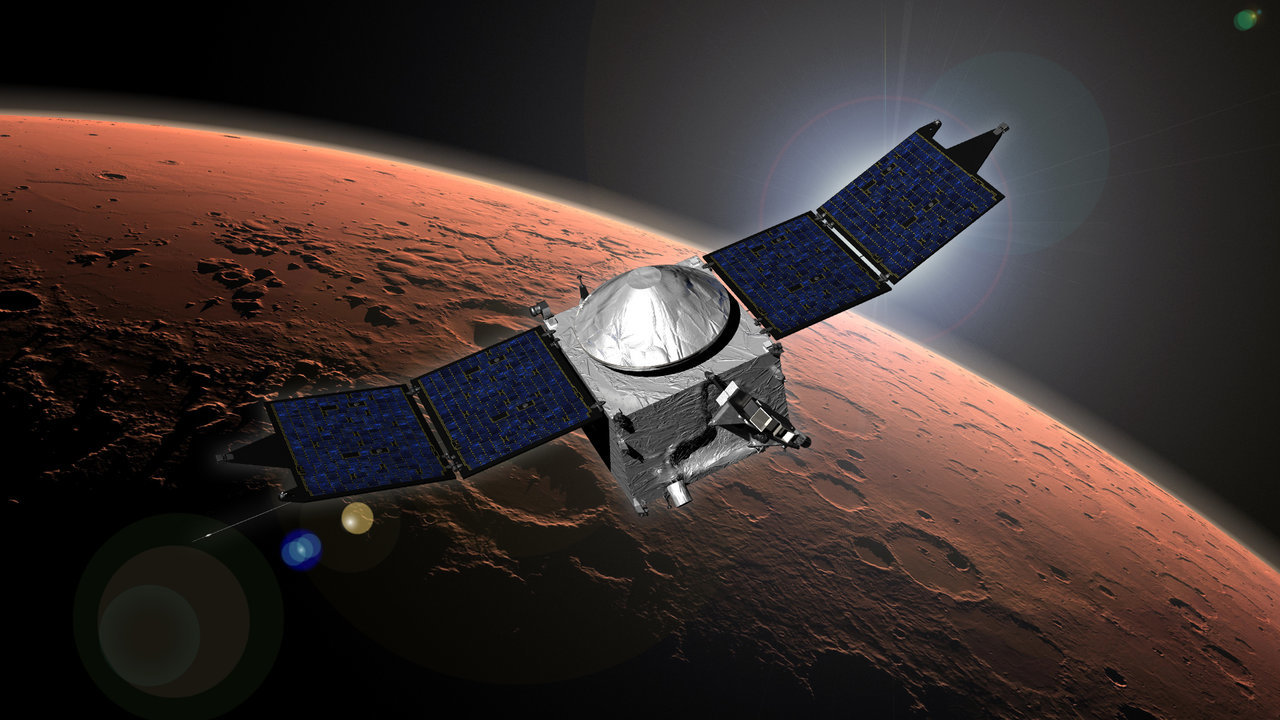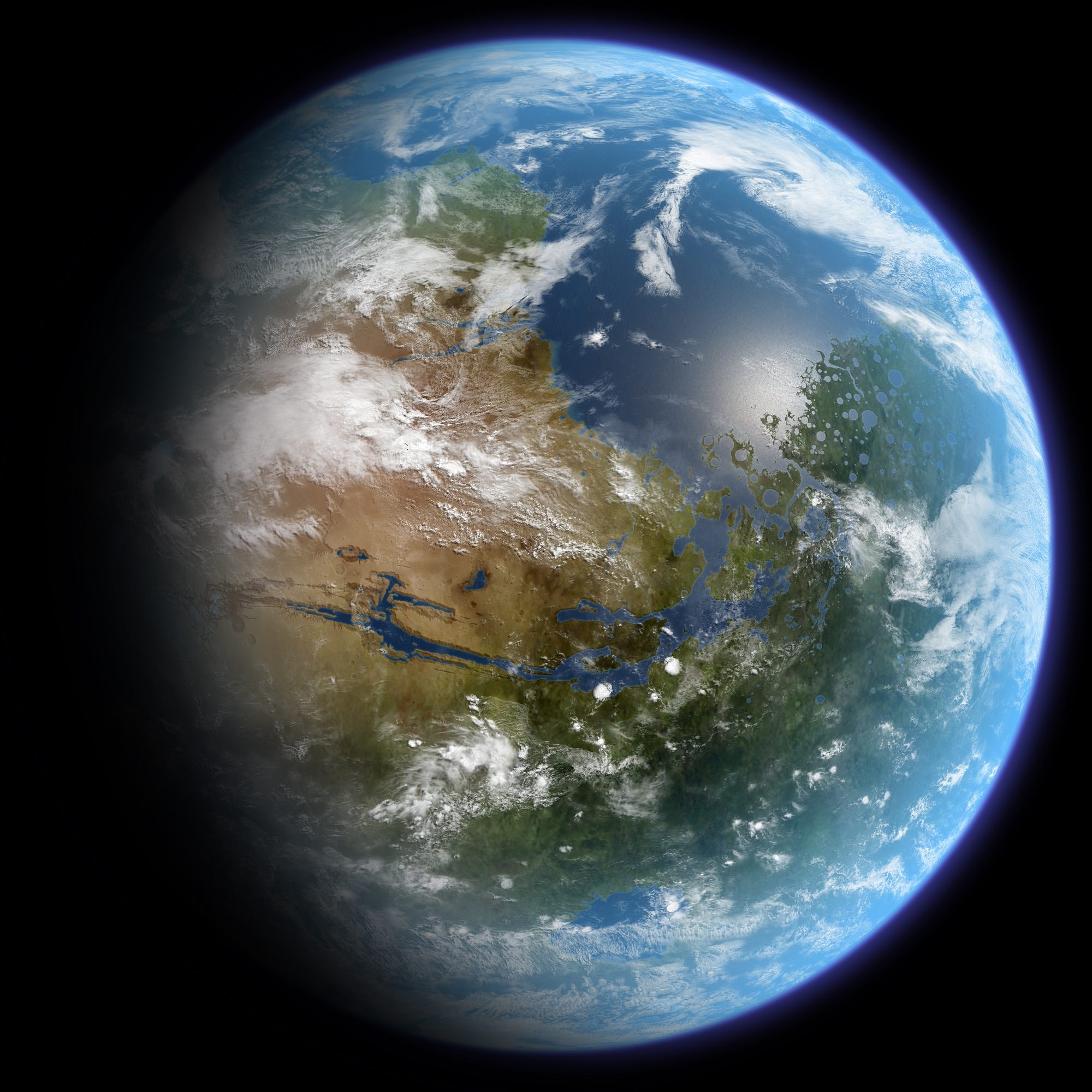After orbiting Mars for eight long years, NASA’s Mars Atmosphere and Volatile EvolutioN (MAVEN) spacecraft observed an extraordinary duo of auroras around the Red Planet that resulted from solar storms emanating from the Sun only a few days earlier on August 27. This observation is extraordinary since Mars lacks a global magnetic field so the solar flares must have been very powerful for MAVEN to detect them.
Continue reading “NASA’s MAVEN Witnessed Auroras as Multiple Solar Storms Crashed into Mars”What Could We Learn From a Mission to Phobos?
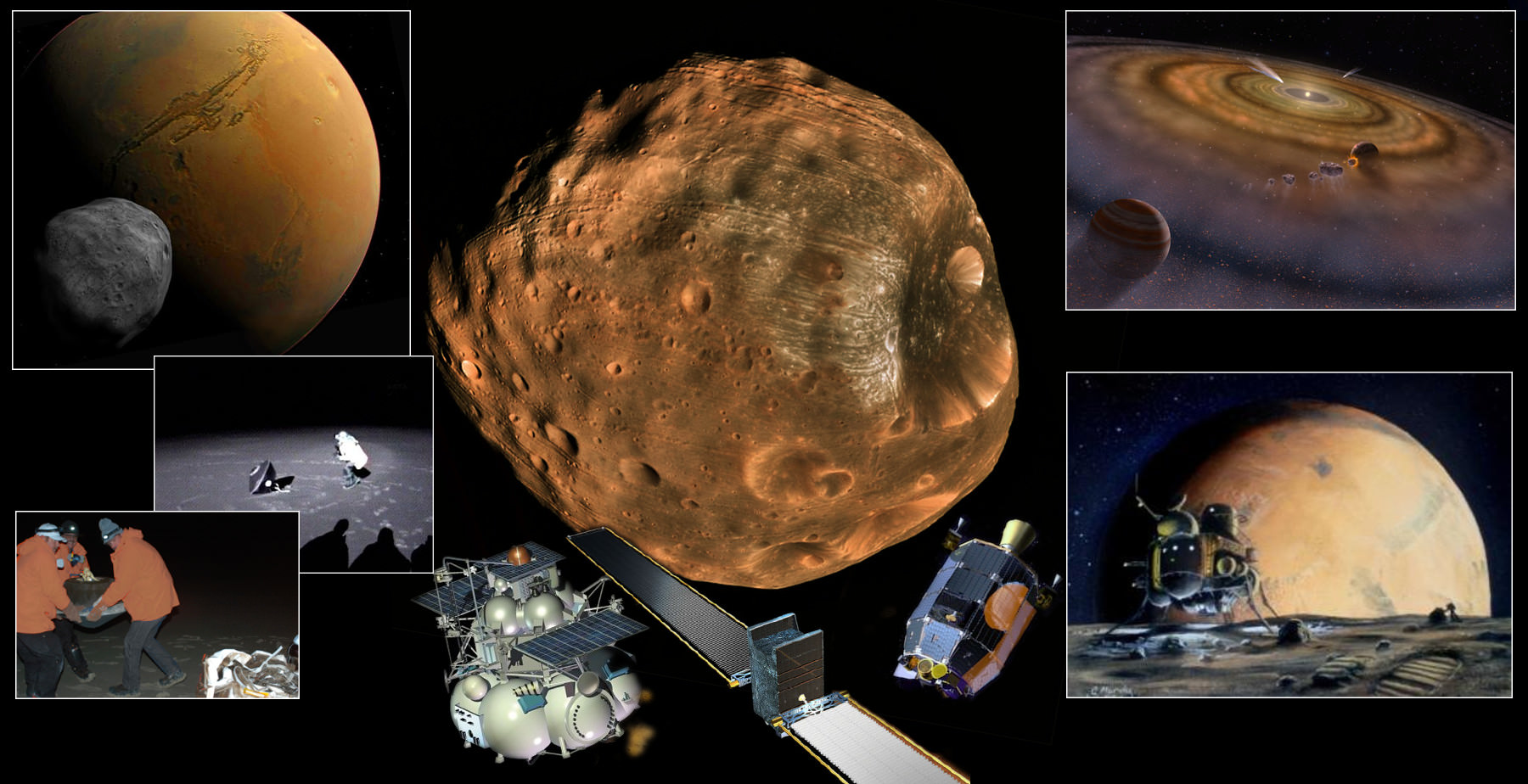
According to new research that appeared in the scientific journal Nature Geoscience, the larger of Mars’ two moons (Phobos) has an orbit that takes it through a stream of charged particles (ions) that flow from the Red Planet’s atmosphere. This process has been taking place for billions of years as the planet slowly lost its atmosphere, effectively establishing a record of Martian climate change on Phobos’ surface.
This research has provided yet another incentive for landing a mission on Phobos, something that has never been done successfully. In essence, this mission could gather sample data that would allow scientists to study this record more closely. In the process, they would be able to learn a great deal more about how Mars went from being a warmer world with liquid water to the extremely arid and cold environment it is today.
Continue reading “What Could We Learn From a Mission to Phobos?”Uh oh, Mars Doesn’t Have Enough Carbon Dioxide to be Terraformed
For almost a century now, the concept of terraforming has been explored at length by both science fiction writers and scientists alike. Much like setting foot on another planet or traveling to the nearest star, the idea of altering an uninhabitable planet to make it suitable for humans is a dream many hope to see accomplished someday. At present, much of that hope and speculation is aimed at our neighboring planet, Mars.
But is it actually possible to terraform Mars using our current technology? According to a new NASA-sponsored study by a pair of scientists who have worked on many NASA missions, the answer is no. Put simply, they argue that there is not enough carbon dioxide gas (CO2) that could practically be put back into Mars’ atmosphere in order to warm Mars, a crucial step in any proposed terraforming process.
The study, titled “Inventory of CO2 available for terraforming Mars“, recently appeared in the journal Nature Astronomy. The study was conducted by Bruce Jakosky – a professor of geological sciences and the associate director of the Laboratory for Atmospheric and Space Physics (LASP) at the University of Colorado, Boulder – and Christopher S. Edwards, an assistant professor of planetary science at Northern Arizona University and the leader of the Edwards Research Group.
The study was supported in part by NASA through the Mars Atmospheric and Volatile EvolutioN (MAVEN) and Mars Odyssey THEMIS (Thermal Emission Imaging System) projects. Whereas Professor Jakosky was the Principal Investigator on the MAVEN mission, Professor Edwards is a participating scientist on the Mars Science Laboratory Curiosity Rover (MSL), and worked on the Mars Odyssey THEMIS mission (among other Mars missions).
As we explored in a previous article, “How Do We Terraform Mars?“, many methods have been suggested for turning the Red Planet green. Many of these methods call for warming the surface in order to melt the polar ice caps, which would release an abundant amount of CO2 to thicken the atmosphere and trigger a greenhouse effect. This would in turn cause additional CO2 to be released from the soil and minerals, reinforcing the cycle further.
According to many proposals, this would be followed by the introduction of photosynthetic organisms such as cyanobacteria, which would slowly convert the atmospheric CO2 into oxygen gas and elemental carbon. This very method was suggested in a 1976 NASA study, titled “On the Habitability of Mars: An Approach to Planetary Ecosynthesis“. Since that time, multiple studies and even student teams have proposed using cyanobacteria to terraform Mars.
However, after conducting their analysis, Professors Jakosky and Edwards concluded that triggering a greenhouse effect on Mars would not be as simple as all that. For the sake of their study, Jakosky and Edwards relied on about 20 years of data accumulated by multiple spacecraft observations of Mars. As Edwards indicated in a recent NASA press release:
“These data have provided substantial new information on the history of easily vaporized (volatile) materials like CO2 and H2O on the planet, the abundance of volatiles locked up on and below the surface, and the loss of gas from the atmosphere to space.”
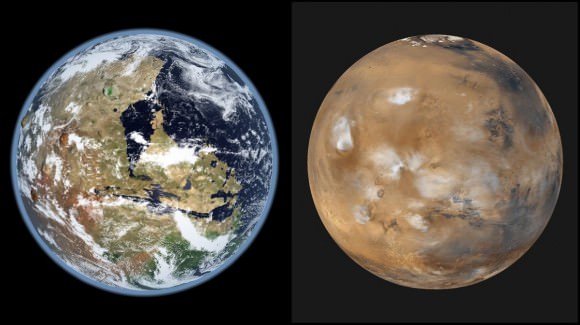
To determine if Mars had enough gases for a greenhouse effect, Jakosky and Edwards analyzed data from NASA’s Mars Reconnaissance Orbiter (MRO) and Mars Odyssey spacecraft to determine the abundance of carbon-bearing minerals in Martian soil and CO2 in polar ice caps. They they used data from NASA’s MAVEN mission to determine the loss of the Martian atmosphere to space. As Prof. Jakosky explained:
“Carbon dioxide (CO2) and water vapor (H2O) are the only greenhouse gases that are likely to be present on Mars in sufficient abundance to provide any significant greenhouse warming… Our results suggest that there is not enough CO2 remaining on Mars to provide significant greenhouse warming were the gas to be put into the atmosphere; in addition, most of the CO2 gas is not accessible and could not be readily mobilized. As a result, terraforming Mars is not possible using present-day technology.”
Although Mars has significant quantities of water ice, previous analyses have shown that water vapor would not be able to sustain a greenhouse effect by itself. In essence, the planet is too cold and the atmosphere too thin for the water to remain in a vaporous or liquid state for very long. According to the team, this means that significant warming would need to take place involving CO2 first.
However, Mars atmospheric pressure averages at about 0.636 kPA, which is the equivalent of about 0.6% of Earth’s air pressure at sea level. Since Mars is also roughly 52% further away from the Sun than Earth (1.523 AUs compared to 1 AU), researchers estimate that a CO2 pressure similar to Earth’s total atmospheric pressure would be needed to raise temperatures enough to allow for water to exist in a liquid state.

According to the team’s analysis, melting the polar ice caps (which is the most accessible source of carbon dioxide) would only contribute enough CO2 to double the Martian atmospheric pressure to 1.2% that of Earth’s. Another source is the dust particles in Martian soil, which the researchers estimate would provide up to 4% of the needed pressure. Other possible sources of carbon dioxide are those that are locked in mineral deposits and water-ice molecule structures known as “clathrates”.
However, using the recent NASA spacecraft observations of mineral deposits, Jakosky and Edwards estimate that these would likely yield less than 5% of the require pressure each. What’s more, accessing even the closest minerals to the surface would require significant strip mining, and accessing all the CO2 attached to dust particles would require strip mining the entire planet to a depth of around 90 meters (100 yards).
Accessing carbon-bearing minerals deep in the Martian crust could be a possible solution, but the depth of these deposits is currently unknown. In addition, recovering them with current technology would be incredibly expensive and energy-intensive, making extraction highly impractical. Other methods have been suggested, however, which include importing flourine-based compounds and volatiles like ammonia.
The former was proposed in 1984 by James Lovelock and Michael Allaby in their book, The Greening of Mars. In it, Lovelock and Allaby described how Mars could be warmed by importing chlorofluorocarbons (CFCs) to trigger global warming. While very effective at triggering a greenhouse effect, these compounds are short-lived and would need to be introduced in significant amounts (hence why the team did not consider them).
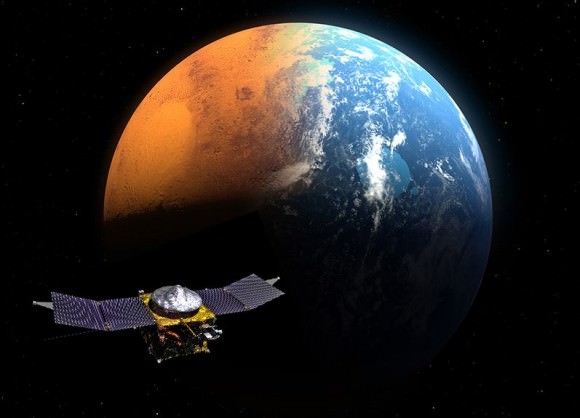
The idea of importing volatiles like ammonia is an even more time-honored concept, and was proposed by Dandridge M. Cole and Donald Cox in their 1964 book, “Islands in Space: The Challenge of the Planetoids, the Pioneering Work“. Here, Cole and Cox indicated how ammonia ices could be transported from the outer Solar System (in the form of iceteroids and comets) and then impacted on the surface.
However, Jakosky and Edwards’ calculations reveal that many thousands of these icy objects would be required, and the sheer distance involved in transporting them make this an impractical solution using today’s technology. Last, but not least, the team considered how atmospheric loss could be prevented (which could be done using a magnetic shield). This would allow for the atmosphere to build up naturally due to outgassing and geologic activity.
Unfortunately, the team estimates that at the current rate at which outgassing occurs, it would take about 10 million years just to double Mars’ current atmosphere. In the end, it appears that any effort to terraform Mars will have to wait for the development of future technologies and more practical methods.
These technologies would most likely involve more cost-effective means for conducting deep-space missions, like nuclear-thermal or nuclear-electric propulsion. The establishment of permanent outposts on Mars would also be an important first step, which could be dedicated to thickening the atmosphere by producing greenhouse gases – something humans have already proven to be very good at here on Earth!
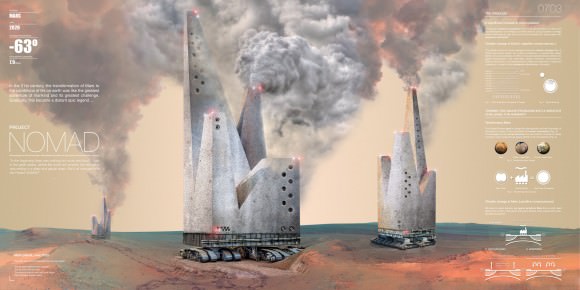
There’s also the possibility of importing methane gas from the outer Solar System, another super-greenhouse gas, which is also indigenous to Mars. While it constitutes only a tiny percentage of the atmosphere, significant plumes have been detected in the past during the summer months. This includes the “tenfold spike” detected by the Curiosity rover in 2014, which pointed to a subterranean source. If these sources could be mined, methane gas might not even need to be imported.
For some time, scientists have known that Mars was not always the cold, dry, and inhospitable place that it is today. As evidenced by the presence of dry riverbeds and mineral deposits that only form in the presence of liquid water, scientists have concluded that billions of years ago, Mars was a warmer, wetter place. However, between 4.2 and 3.7 billion years ago, Mars’ atmosphere was slowly stripped away by solar wind.
This discovery has led to renewed interest in the colonizing and terraforming of Mars. And while transforming the Red Planet to make it suitable for human needs may not be doable in the near-future, it may be possible to get the process started in just a few decades’ time. It may not happen in our lifetime, but that does not mean that the dream of one-day making “Earth’s Twin” truly live up to its name won’t come true.
Further Reading: NASA
How Long Can a Rocky World Withstand the Blasts From a Red Dwarf Star?

Red dwarf stars have become a major focal point for exoplanet studies lately, and for good reason. For starters, M-type (red dwarf) stars are the most common type in our Universe, accounting for 75% of stars in the Milky Way alone. In addition, in the past decade, numerous terrestrial (i.e rocky) exoplanets have been discovered orbiting red dwarf stars, and within their circumstellar habitable zones (“Goldilocks Zones”) to boot.
This has naturally prompted several studies to determine whether or not rocky planets can retain their atmospheres. The latest study comes from NASA, using data obtained by the Mars Atmosphere and Volatile Evolution (MAVEN) orbiter. Having studied Mars’ atmosphere for years to determine how and when it was stripped away, the MAVEN mission is well-suited when it comes to measuring the potential habitability of other planets.
The study was shared on Dec. 13th, 2017, at the Fall Meeting of the American Geophysical Union in New Orleans, Louisiana. In a presentation titled “Spanning Disciplines to Search for Life Beyond Earth“, a team of NASA scientists and researchers from the University of California-Riverside and the University of Colorado-Boulder explained how insights from the MAVEN mission could be applied to the habitability of rocky planets orbiting other stars.

Launched in November 18th, 2013, the MAVEN mission established orbit around Mars on September 22nd, 2014. The purpose of this mission has been to explore the Red Planet’s upper atmosphere, ionosphere and its interactions with the Sun and solar wind for the sake of determining how and when Mars’ atmosphere went from being thicker and warmer in the past (and thus able to support liquid water on the surface) to thin and tenuous today.
Since November of 2014, MAVEN has been measuring Mars’ atmospheric loss using its suite of scientific instruments. From the data it has obtained, scientists have surmised that the majority of the planet’s atmosphere was lost to space over time due to a combination of chemical and physical processes. And in the past three years, the Sun’s activity has increased and decreased, giving MAVEN the opportunity to observe how Mars’ atmospheric loss has risen and fallen accordingly.
Because of this, David Brain – a professor at the Laboratory for Atmospheric and Space Physics (LASP) at the CU Boulder is also a MAVEN co-investigator – and his colleagues began to think about how these insights could be applied to a hypothetical Mars-like planet orbiting around an red dwarf star. These planets include Proxima b (the closest exoplanet to our Solar System) and the seven planet system of TRAPPIST-1.
As Brain he explained in a recent NASA press release:
“The MAVEN mission tells us that Mars lost substantial amounts of its atmosphere over time, changing the planet’s habitability. We can use Mars, a planet that we know a lot about, as a laboratory for studying rocky planets outside our solar system, which we don’t know much about yet.”
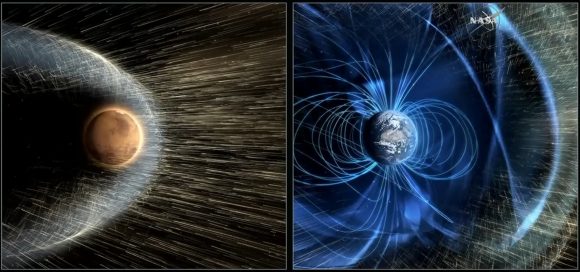
To determine if this hypothetical planet could retain its atmosphere over time, the researchers performed some preliminary calculations that assumed that this planet would be positioned near the outer edge of the star’s habitable zone (as Mars is). Since red dwarf’s are dimmer than our Sun, the planet would have to orbit much closer to the star – even closer than Mercury does to our Sun – to be within this zone.
They also considered how a higher proportion of the light emanating from red dwarf stars is in the ultraviolet wavelength. Combined with a close orbit, this means that the hypothetical planet would be bombarded with about 5 times more UV radiation the real Mars gets. This would also mean that the processes responsible for atmospheric loss would be increased for this planet.
Based on data obtained by MAVEN, Brain and colleagues were able to estimate how this increase in radiation would affect Mars’ own atmospheric loss. Based on their calculations, they found that the planet’s atmosphere would lose 3 to 5 times as many charged particles through ion escape, while about 5 to 10 times more neutral particles would be lost through photochemical escape (where UV radiaion breaks apart molecules in the upper atmosphere).
Another form of atmospheric loss would also result, due to the fact that more UV radiation means that more charged particles would be created. This would result in a process called “sputtering”, where energetic particles are accelerated into the atmosphere and collide with other molecules, kicking some out into space and sending others crashing into neighboring particles.
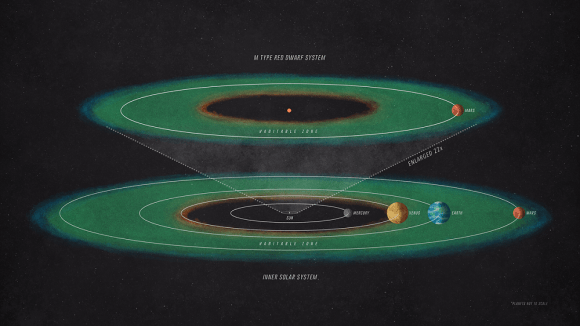
Lastly, they considered how the hypothetical planet might experience about the same amount of thermal escape (aka. Jeans escape) as the real Mars. This process occurs only for lighter molecules such as hydrogen, which Mars loses at the top of its atmosphere through thermal escape. On the “exo-Mars”, however, thermal escape would increase only if the increase in UV radiation were to push more hydrogen into the upper atmosphere.
In conclusion, the researchers determined that orbiting at the edge of the habitable zone of a quiet M-type star (instead of our Sun) could shorten the habitable period for a Mars-like planet by a factor of about 5 to 20. For a more active M-type star, the habitable period could be cut by as much as 1,000 times. In addition, solar storm activity around a red dwarf, which is thousands of times more intense than with our Sun, would also be very limiting.
However, the study is based on how an exo-Mars would fair around and M-type star, which kind of stacks the odds against habitability in advance. When different planets are considered, which possess mitigating factors Mars does not, things become a bit more promising. For instance, a planet that is more geologically active than Mars would be able to replenish its atmosphere at a greater rate.
Other factors include increase mass, which would allow for the planet to hold onto more of its atmosphere, and the presence of a magnetic field to shield it from stellar wind. As Bruce Jakosky, MAVEN’s principal investigator at the University of Colorado (who was not associated with this study), remarked:
“Habitability is one of the biggest topics in astronomy, and these estimates demonstrate one way to leverage what we know about Mars and the Sun to help determine the factors that control whether planets in other systems might be suitable for life.”
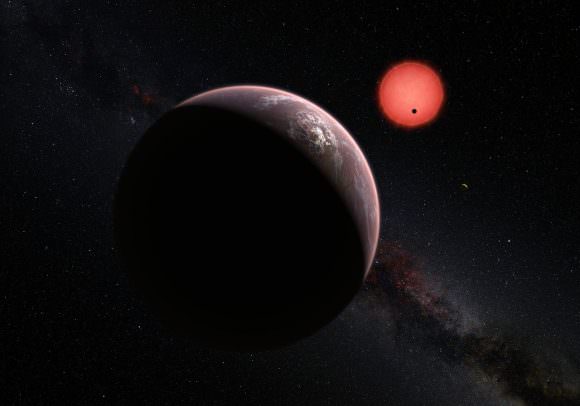
In the coming years, astronomers and exoplanet researchers hope to learn more about the planets orbiting nearby red dwarf stars. These efforts are expected to be helped immensely thanks to the deployment of the James Webb Space Telescope, which will be able to conduct more detailed surveys of these star systems using its advanced infrared imaging capabilities.
These studies will allow scientists to place more accurate constraints on exoplanets that orbit red dwarf stars, which will allow for better estimates about their size, mass, and compositions – all of which are crucial to determining potential habitability.
and Katherine Garcia-Sage of NASA Goddard Space Flight Center and of the University of California-Riverside. You can access the press conference materials by going to NASA Goddard Media Studios.
How Long is a Day on Mars?
Mars represents something of a conundrum for scientists. In many respects, it is significantly different from Earth. It’s cold, it’s dry, there is little atmosphere or precipitation to speak of, and nothing grows there. By our standards, that makes it an incredibly inhospitable place. And yet, in many other respects, it is quite similar to our world.
For instance, Mars’ internal structure is differentiated between a metallic core and a silicate mantle and crust. It also has plenty of water, though the majority of it is concentrated in the polar regions as water ice (and as a permanent layer of permafrost under much of the surface). But perhaps most striking of all, a day on Mars is almost the same as a day here on Earth.
In fact, a day on Mars is roughly 40 minutes longer than a day is here on Earth. Compared to other bodies in our Solar System where a day is either incredibly short (Jupiter’s rotates once on its axis every 9 hours, 55 minutes and 29.69 seconds) or incredibly long (a day on Venus lasts for 116 days and 18 hours), this similarity is quite astounding.
However, there are some things that need to be addressed before we go about declaring just how long a day is on another planet. In fact, there are two ways to determine the length of a day on a celestial body, the sidereal day and the solar day; both of which are used by astronomers for determining the passage on time.
Sidereal vs. Solar:
By definition, a sidereal day on Mars is the length of time that it takes the planet to rotate once on its axis so that stars appear in the same place in the night sky. On Earth, this takes exactly 23 hours, 56 minutes and 4.1 seconds. In comparison, on Mars, a sidereal day lasts 24 hours, 37 minutes, and 22 seconds.
The solar day, by contrast, is the time it takes for the Earth to rotate on its axis so that the Sun appears in the same position in the sky. This position changes slightly each day, but on Earth, a mean solar day works out to being 24 hours long. On Mars, a solar day lasts 24 hours, 39 minutes, and 35 seconds. Rounding that out, we say that a day here on Earth works out to an even 24 hours while on Mars, a day lasts 24 hours and 40 minutes.
Want to know about some other interesting similarities Mars has with Earth? Read on!
Seasonal Changes:
Mars also has a seasonal cycle that is similar to that of Earth’s. This is due in part to the fact that Mars also has a tilted axis, which is inclined 25.19° to its orbital plane (compared to Earth’s axial tilt of approx. 23.44°). It’s also due to Mars orbital eccentricity, which mean that it ranges in distance from 206.7 million to 249.2 million kilometers from the Sun.
This change in distance causes significant variations in temperature. While the planet’s average temperature is -46 °C (51 °F), this ranges from a low of -143 °C (-225.4 °F) during the winter at the poles to a high of 35 °C (95 °F) during summer and midday at the equator. This high in temperatures is what allows for liquid water to still flow, albeit intermittently, on the surface of Mars.
It also snows on Mars. In 2008, NASA’s Phoenix Lander found water ice in the polar regions of the planet. This was an expected finding, but scientists were not prepared to observe snow falling from clouds. The snow, combined with soil chemistry experiments, led scientists to believe that the landing site had a wetter and warmer climate in the past.

And then in 2012, data obtained by the Mars Reconnaissance Orbiter revealed that carbon-dioxide snowfalls occur in the southern polar region of Mars. For decades, scientists have known that carbon-dioxide ice is a permanent part of Mars’ seasonal cycle and exists in the southern polar caps. But this was the first time that such a phenomena was detected, and it remains the only known example of carbon-dioxide snow falling anywhere in our solar system.
In addition, recent surveys conducted by the Mars Reconnaissance Orbiter, the Mars Science Laboratory, the Mars Orbiter Mission (MOM), the Mars Atmosphere and Volatile Evolution (MAVEN) and the Opportunity and Curiosity Rovers have revealed some startling things about Mars’ deep past.
For starters, soil samples and orbital observation have demonstrated conclusively that roughly 3.7 billion years ago, the planet had more water on its surface than is currently in the Atlantic Ocean. Similarly, atmospheric studies conducted on the surface and from space have proven that Mars also had a viable atmosphere at that time, one which was slowly stripped away by solar wind.
Weather Patterns:
Like Earth, Mars can have some pretty extreme weather. In the Red Planet’s case, this takes the form of dust storms that can dominated the surface from time to time. These storms have been known to grow to be thousands of kilometers across, occasionally encircling the entire planet and covering everything in a thick haze of dust. When these storms become that large, they prevent direct observation of the Martian surface.
Case in point: when the Mariner 9 orbiter became the first spacecraft to orbit Mars in 1971, it sent pictures back to Earth of a world consumed in haze. The entire planet was covered by a dust storm so massive that only Olympus Mons, the giant Martian volcano that measures 24 km high, could be seen above the clouds. This storm lasted for a full month, and delayed Mariner 9‘s attempts to photograph the planet in detail.
And then on June 9th, 2001, the Hubble Space Telescope spotted a dust storm in the Hellas Basin on Mars. By July, the storm had died down, but then grew again to become the largest storm in 25 years. So big was the storm that amateur astronomers using small telescopes were able to see it from Earth. And the cloud raised the temperature of the frigid Martian atmosphere by a stunning 30° Celsius.
Therein lies another thing Mars has in common with Earth – global warming! Much like warming trends here on Earth, warming on Mars is caused by the presence of particulate matter in the air that absorbs energy from the Sun and radiates it outward into the atmosphere. causing average temperatures to rise.
These storms tend to occur when Mars is closest to the Sun, and are the result of temperatures rising and triggering changes in the air and soil. As the soil dries, it becomes more easily picked up by air currents, which are caused by pressure changes due to increased heat. The dust storms cause temperatures to rise even further, so you could say Mars has a “greenhouse effect” of its own!
As you have probably concluded from all the facts listed above, Mars can be a harsh and volatile planet. Just knowing the answer to ”how long is a day on Mars?” only provides a small glimpse of what is going on there. At the end of the day (no pun intended!) there is plenty happening on Mars that makes it similar enough to Earth that many people are actually contemplating living there someday. And knowing exactly what sets Mars apart, and what we can work with, will be intrinsic to making that happen!
We have written many interesting articles about Mars here at Universe Today. Here’s one about Mars Compared to Earth, the time it takes to get to Mars, how strong the gravity is on Mars, and how many moons Mars has.
Want more information? Learn about living on Mars time, which can you do by consulting NASA’s clock for calculating Martian time.
Finally, if you’d like to learn more about Mars in general, Astronomy Cast has some episodes about the Red Planet, like Episode 52: Mars, and Episode 91: The Search for Water on Mars.

